Outhouse

An outhouse, also known by many other names, is a small structure, separate from a main building, which covers one or more toilets. This is typically either a pit latrine (long drop) or a bucket toilet, but other forms of dry (non-flushing) toilets may be encountered. The term may also be used to denote the toilet itself, not just the superstructure.
Outhouses were in use in cities of developed countries (e.g. Australia) well into the second half of the twentieth century. They are still common in rural areas and also in cities of developing countries. Outhouses that are covering pit latrines in densely populated areas can cause groundwater pollution.
In some localities and varieties of English, particularly outside North America, the term "outhouse" refers not to a toilet, but to outbuildings in a general sense: sheds, barns, workshops, etc.
Design aspects
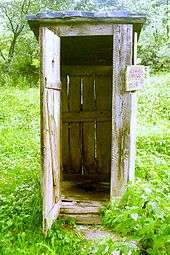
Common features
Outhouses vary in design and construction. They are by definition outside the dwelling, and are not connected to plumbing, sewer, or septic system. The World Health Organization recommends they be built a reasonable distance from the house balancing issues of easy access versus that of smell.[1]
The superstructure exists to shelter the user, and also to protect the toilet itself. The primary purpose of the building is for privacy and human comfort, so that the user is not exposed and does not get wet when it is raining or cold when it is windy. Walls and a roof for privacy and to shield the user from the elements—rain, wind, sleet and snow (depending on locale)—and thus to a small degree, cold weather. However, the building has the secondary effect of protecting the toilet hole from large influxes of water when it is raining, which would flood the hole and flush untreated wastes into the underlying soils before they can decompose.
Outhouses are commonly humble and utilitarian, made of lumber or plywood. This is especially so they can easily be moved when the earthen pit fills up. Depending on the size of the pit and the amount of use, this can be fairly frequent, sometimes yearly. As pundit "Jackpine" Bob Cary wrote: "Anyone can build an outhouse, but not everyone can build a good outhouse."[2] Floor plans typically are rectangular or square, but hexagonal outhouses have been built.[3]
The arrangements inside the outhouse vary by culture. In Western societies, many, though not all, have at least one seat with a hole in it, above a small pit. Others, often in more rural, older areas in European countries, simply have a hole with two indents on either side for your feet. In Eastern societies, there is a hole in the floor, over which the user crouches. A roll of toilet paper is usually available. Old corn cobs, leaves, or other types of paper are also used.
The decoration on the outhouse door has no standard. The well-known crescent moon on American outhouses was popularized by cartoonists and had a questionable basis in fact. There are authors who claim the practice began during the colonial period as an early "mens"/"ladies" designation for an illiterate populace (the sun and moon being popular symbols for the sexes during those times).[4] Others dismiss the claim as an urban legend.[n 1] What is certain is that the purpose of the hole is for venting and light and there were a wide variety of shapes and placements employed.
Different systems
The shelter may cover very different sorts of toilets. A common one is the pit latrine or pit toilet, which collects human feces in a hole in the ground. When properly built and maintained they can decrease the spread of disease by reducing the amount of human feces in the environment from open defecation.[6] When the pit fills to within 0.5 meters (1.6 feet) of the top, it should be either emptied or a new pit constructed and the shelter moved or re-built at the new location.[7] The management of the fecal sludge removed from the pit is complicated. There are both environment and health risks if not done properly. As of 2013 pit latrines are used by an estimated 1.77 billion people.[8] This is mostly in the developing world as well as in rural and wilderness areas.
Another system is the bucket toilet, consisting of a seat and a portable receptacle (bucket or pail). These may be emptied by their owners into composting piles in the garden (a low-tech composting toilet), or collected by contractors for larger-scale disposal. Historically, this was known as the pail closet; the municipality employed workers, often known as "nightmen" (from night soil), to empty and replace the buckets. This system was associated in particular with the English town of Rochdale, to the extent that it was described as the "Rochdale System" of sanitation.[9][10] 20th century books report that similar systems were in operation in parts of France and elsewhere in continental Europe.[9] The system of municipal collection was widespread in Australia; "dunny cans" persisted well into the second half of the twentieth century,[11] see below. In Scandinavia and some other countries, outhouses are built over removable containers that enable easy removal of the waste and enable much more rapid composting in separate piles. A similar system operates in India, where hundreds of thousands of workers engage in manual scavenging, i.e. emptying pit latrines and bucket toilets without any personal protective equipment.[12][13][14]
High-tech systems are used in some national parks and popular wilderness areas, to cope with the increased volume of people engaged in activities such as mountaineering and kayaking. The growing popularity of paddling, hiking, and climbing has created special waste disposal issues throughout the world. It is a dominant topic for outdoor organizations and their members.[15] For example, in some places the sewage is collected in drums which need to be helicoptered in and out at considerable expense. Alternatively, some parks mandate a "pack it in, pack it out" rule. Many reports document the use of containers for the removal of excrement, which must be packed in and packed out on Mount Everest. Also known as "expedition barrels"[16] or "bog barrels",[17] the cans are weighed to make sure that groups do not dump them along the way.[18] "Toilet tents" are erected.[19][20] This would seem to be an improvement over the prior practices, including the so-called "McKinley system"; there has been an increasing awareness that the mountain needs to be kept clean, for the health of the climbers at least.[16] Worm hold privies, another variant of the composting toilet, are being used by Vermont's Green Mountain Club. These simple outhouses are stocked with red worms (a staple used by home composters).[15] Despite their environmental benefits, composting toilets are likewise subject to regulations.[21]
There are other types of toilet that may be covered by an outhouse superstructure, or a toilet tent (e.g. in humanitarian relief operations), or even be installed inside a house that is beyond the reach of sewers. The Swedish Pacto toilet uses a continuous roll of plastic to collect and dispose of waste.[22] A modern analogy to the outhouse is the "Clivus Multrum", which is an electric and waterless composting toilet. They are an alternative to outhouses and septic fields, and provide effective sanitation in areas too remote for sewer lines. Incinerating toilets are installed in several thousand cabins in Norway.[23] These toilets incinerate waste into ashes, using only propane and 12 volt electricity.
Public health issues
Outhouse design, placement, and maintenance has long been recognized as being important to the public health. See posters created by the Works Progress Administration.[24]
Insect control
Some types of flying insects such as the housefly are attracted to the odor of decaying material, and will use it for food for their offspring, laying eggs in the decaying material. Other insects such as mosquitoes seek out standing water that may be present in the pit for the breeding of their offspring.
Both of these are undesirable pests to humans, but can be easily controlled without chemicals by enclosing the top of the pit with tight-fitting boards or concrete, using a toilet hole cover that is closed after every use, and by using fine-grid insect screen to cover the inlet and outlet vent holes. This prevents flying insect entry by all potential routes.
Parasites
One of the purposes of outhouses is to avoid spreading parasites such as intestinal worms, notably hookworms, which might otherwise be spread via open defecation.
Uses
Outhouses on mountain peaks
- On August 29, 2007, the highest outhouse (actually, not a building at all, but a pit toilet surrounded by a low rock wall) in the continental United States, which sat atop Mount Whitney at about 14,494 feet (4,418 m) above sea level, offering a magnificent panorama to the user, was removed. Two other outhouses, in the Inyo National Forest, were closed due to the expense and danger involved in transporting out large sewage drums via helicopter. The annual 19,000 or so hikers of the Mount Whitney Trail, who must pick up National Forest Service permits, are now given Wagbags (a double-sealed sanitation kit) and told how to use them. "Pack it in; pack it out" is the new watchword.[25] Solar-powered toilets did not sufficiently compact the excrement, and the systems were judged failures at that location. Additionally, by relieving park rangers of latrine duty, they were better able to concentrate on primary ranger duties such as talking to hikers.[26] The use of Wagbags and the removal of outhouses is part of a larger trend in U.S. parks.[25] The U.S. National Park Service once built an outhouse that cost above $333,000.[27]
- In 2007, Europe's two highest outhouses were helicoptered to the top of France's Mont Blanc at a height of 4,260 metres (13,980 ft). The containers from these outhouses are emptied by helicopter. The facilities will serve 30,000 skiers and hikers annually, thus helping to alleviate the deposit of urine and feces that spread down the mountain face with the spring thaw, and turned it into 'Mont Noir'.[28] More technically, the 2002 book Le versant noir du mont Blanc ("The black hillside of Mont Blanc") exposes problems in conserving the site.[29]
- Upon the 5,642-metre (18,510 ft) Mount Elbrus—Russia's highest peak, the highest mountain in all of Europe and topographically dividing Europe from Asia—sits the world's "nastiest outhouse" at 4,206 metres (13,799 ft). It is in the Caucasus Mountains, near the frontier between Georgia and Russia. As one writer opined, "...it does not much feel like Europe when you're there. It feels more like Central Asia or the Middle East."[30][31] The outhouse is surrounded by and covered in ice, perched off the end of a rock, and with a pipe pouring effluvia onto the mountain. It consistently receives low marks for sanitation and convenience, but is considered to be a unique experience.[32]
- Australia's highest outhouse — located at Rawson's Pass in the Main Range in Kosciuszko National Park, which each year receives more than 100,000 walkers outside of winter and has a serious human waste management issue, was completed in 2008.[33]
- A stone outhouse in Colca Canyon, Peru, has been claimed to be "the world's highest".[34]
History


Old outhouse pits are seen as excellent places for archeological and anthropological excavations, offering up a trove of common objects from the past—a veritable inadvertent time capsule—which yields historical insight into the lives of the bygone occupants. This is also called privy digging. It is especially common to find old bottles, which seemingly were secretly stashed or trashed, so their content could be privately imbibed.[35][36][37] Fossilised feces (coprolites) yield much information about diet and health.
Australia and New Zealand
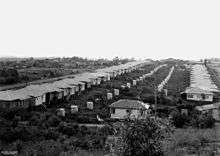
"Dunny" or "dunny can" are Australian and New Zealand words for a toilet, particularly an outhouse. For other uses of the word, see Dunny (disambiguation).
In suburban areas not connected to the sewerage, outhouses were not always built over pits. Instead, these areas utilized a pail closet, where waste was collected into large cans positioned under the toilet seat, to be collected by contractors (or night soil collectors) hired by property owners or the local council. The used cans were replaced with empty, cleaned cans. Brisbane relied on "dunny carts" until the 1950s (one source says until the 1970s[38][39]); because the population was so dispersed, it was difficult to install sewerage.[40] Tar, creosote, and disinfectant kept the smell down.[41] Academic George Seddon claimed that "the typical Australian back yard in the cities and country towns" had, throughout the first half of the twentieth century, "a dunny against the back fence, so that the pan could be collected from the dunny lane through a trap-door"[42] The person who appeared weekly to empty the buckets beneath the seats was known as the "dunnyman", see gong farmer.
The "dunny lanes" provided access to collectors. These access lanes can now be worth considerable sums[43] see Ransom strip.
The Great Australian Dunny Race has become an icon during the Weerama Festival at Werribee.[44]
U.S.
Outhouses are typically built on one level, but two-story models are to be found in unusual circumstances. One double-decker was built to serve a two-story building in Cedar Lake, Michigan. The outhouse was connected by walkways. It still stands (but not the building).[n 2] The waste from "upstairs" is directed down a chute separate from the "downstairs" facility in these instances, so contrary to various jokes about two-story outhouses, the user of the lower level has nothing to fear if the upper level is in use at the same time.
The Boston Exchange Coffee House (1809–1818) was equipped with a four-story outhouse[46] with windows on each floor[47]
Some outhouses were built surprisingly ornate, almost opulent, considering the time and the place.[48] For example, an opulent 19th century antebellum example (a three-holer) is at the plantation area at the state park in Stone Mountain, Georgia.[49] The outhouses of Colonial Williamsburg varied widely, from simple expendable temporary wood structures to high-style brick.[50] See Jefferson's matched pair of eight-sided brick privies.[50] Thomas Jefferson designed and had built two brick octagons at his vacation home.[50]Such outhouses are sometimes considered to be overbuilt, impractical and ostentatious, giving rise to the simile "built like a brick shithouse." That phrase's meaning and application is subject to some debate; but (depending upon the country) it has been applied to men, women, or inanimate objects.
With regards to toilet paper, old newspapers and catalogs from retailers specializing in mail order purchases, such as the Montgomery Ward or Sears Roebuck catalog, were common before toilet paper was widely available. Paper was often kept in a can or other container to protect it from mice, etc. The catalogs served a dual purpose, also giving one something to read.[51]
Names
These outdoor toilets are referred to by many terms throughout the English-speaking world.[n 3] It is not always easy to determine whether a given term was restricted to an outdoor toilet, or whether the meaning had extended, over time and with the development of indoor plumbing, to any toilet. The term "outhouse" is used in North American English for the structure over a toilet, usually a pit latrine ("long drop"). However, in British English "outhouse" means any outbuilding, such as a shed or barn.
"Privy", an archaic variant of "private", is used in North America, Scotland, and northern England. "Bog" is common throughout Britain (used to coin the neologism "tree bog"). In Australia and New Zealand, an outdoor toilet is known as a "dunny". The name "little house"[52] (as ty bach) continues as Welsh slang for any toilet. Other terms include "back house", "house of ease", and "house of office". The last was common in 17th-century England and appeared in Samuel Pepys's Diary on numerous occasions.[53]
In the Scouting Movement in North America, a widespread term for outhouse is "kybo". This appears to have originated from camps which used Kybo brand coffee cans to hold lye or lime which was sprinkled down the hole to reduce odor. "Keep Your Bowels Open" may be a backronym. [55][56] Temporary encampments may use a tent or tarpaulin over a shallow pit; one name for this is a "hudo".
Society and culture
Mythology
Tsi-Ku, also known as Tsi Ku Niang, is described as the Chinese goddess of the outhouse and divination. It is said that a woman could uncover the future by going to the outhouse to ask Tsi-Ku.[57][58] See toilet god.
Regulations
United States
Construction and maintenance of outhouses in the U.S. is subject to state and local governmental restriction, regulation and prohibition.[59] It is potentially both a public health issue, which has been addressed both by law and by education of the public as to good methods and practices (e.g., separation from drinking water sources). This also becomes a more prevalent issue as urban and suburban development encroaches on rural areas,[60] and is an external manifestation of a deeper cultural conflict.[61] See also urban sprawl, urban planning, regional planning, suburbanization, urbanization and counterurbanization.
Songs and stories
- The double-decker outhouse has been used as an unflattering metaphor for the "Trickle-down theory" of politics, economics, command, management, labor relations, responsibility, etc.[62][63] Depending on who is depicted on top and below, it is an easy and familiar cartoon.[64]
- On November 10, 2003, a drawing of an outhouse was used by B.C. cartoonist Johnny Hart as a motif in a controversial and allegedly religiously-themed piece.[65] The cartoonist denied the allegations and the convoluted analysis of the alleged iconography of the cartoon.
- Charles "Chic" Sale was a famous comedian in vaudeville and the movies. In 1929 he published a small book, The Specialist,[66] which was a hugely popular "underground" success. Its entire premise centered on sales of outhouses, touting the advantages of one kind or another, and labeling them in "technical" terms such as "one-holers", "two-holers", etc. Over a million copies were sold. In 1931 his monologue "I'm a Specialist"[67] was made into a hit record (Victor 22859) by popular recording artist Frank Crumit (music by Nels Bitterman). As memorialized in the "Outhouse Wall of Fame",[68] the term "Chic Sale" became a rural slang synonym for privies, an appropriation of Mr. Sale's name that he personally considered unfortunate. (See Outhouse humor.)
- Folk singer Billy Edd Wheeler wrote and performed a song titled "The Little Brown Shack Out Back", a sentimental look at the outhouse.[69]
- In Newfoundland, a well-known song entitled "Good Old Newfie Outhouse" sings the praises of using the outhouse when it is -25 degrees out, mentioning pleasures like pants being frozen in position at the knees. A version by singer Bobby Evans is available on an album called Silly Songs on iTunes.[70]
Races and pranks
- In Michigan, the Upper Peninsula's Trenary has the largest outhouse race,[71][72] but Mackinaw City is home to an annual and largest "outhouse race south of the Mackinac Bridge".[73] Other famous outhouse races are during the Yale Bologna Festival and in Dawson City, Yukon.
- As a college student, Richard Nixon achieved renown by providing a three-hole outhouse to be tossed onto the traditional campus bonfire.[74]
Gallery
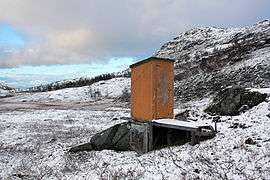 Outhouse in the mountains in northern Norway
Outhouse in the mountains in northern Norway
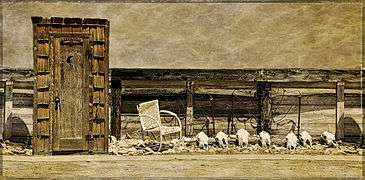
- Outhouse used in the 19th century: Manistee Ranch in Glendale, Arizona, U.S.
 Outhouse used in the 19th century: Sahuaro Ranch in Glendale, Arizona, U.S.
Outhouse used in the 19th century: Sahuaro Ranch in Glendale, Arizona, U.S. Eight-seat stone outhouse at the Thomas Leiper Estate near Wallingford, Pennsylvania
Eight-seat stone outhouse at the Thomas Leiper Estate near Wallingford, Pennsylvania- Triple-seated outhouse, Wauchope, New South Wales, Australia
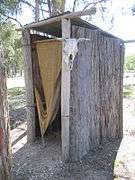 Outhouse at Walcha, New South Wales, Australia
Outhouse at Walcha, New South Wales, Australia
See also
Notes
- ↑ Discussion of outhouses as vernacular architecture (including crescent moon folklore), from the Missouri Folklore Society.[5]
- ↑ 7620 N. Academy Rd, Cedar Lake, Michigan.[45]
- ↑ For a full list of synonyms, see "bathroom" at Wikisaurus.
References
Citations
- ↑ "Simple pit latrines". WHO. 1996. Retrieved 2 August 2016.
- ↑ Cary, "Jackpine" Bob (2003). The All-American Outhouse–Stories, Design & Construction (print). Cambridge, MN: Adventure Publications. ISBN 978-1-59193-011-2.
- ↑ "Sewer History: Photos and Graphics".
- ↑ Adams, Cecil (January 9, 1987). "The Straight Dope: Why do outhouse doors have half-moons on them?".
- ↑ "Missouri Outhouses". Missouri Folklore Society. Retrieved November 27, 2014.
- ↑ "Call to action on sanitation" (PDF). United Nations. Retrieved 15 August 2014.
- ↑ François Brikké (2003). Linking technology choice with operation and maintenance in the context of community water supply and sanitation (PDF). World Health Organization. p. 108. ISBN 9241562153.
- ↑ Graham, JP; Polizzotto, ML (May 2013). "Pit latrines and their impacts on groundwater quality: a systematic review.". Environmental Health Perspectives. 121 (5): 521–30. doi:10.1289/ehp.1206028. PMID 23518813.
- 1 2 Prescott Folwell, A (1901). The designing, Construction, and Maintenance of Sewerage Systems. John Wiley & Sons.
- ↑ Dr Leslie Rosenthal (28 April 2014). The River Pollution Dilemma in Victorian England: Nuisance Law versus Economic Efficiency. Ashgate Publishing, Ltd. pp. 25–26. ISBN 978-1-4724-0420-6.
- ↑ Paul, Rhyll (2012). Pebbles in the Road.
- ↑ "Human rights and manual scavenging" (PDF). Know Your Rights Series. National Human Rights Commission. Retrieved September 16, 2013.
- ↑ "Swachh Bharat Abhiyan should aim to stamp out manual scavenging".
- ↑ Umesh IsalkarUmesh Isalkar, TNN (30 April 2013). "Census raises stink over manual scavenging". The Times of India. Retrieved 6 September 2015.
- 1 2 Motavalli, Jim (1998). "Flushed with success: new waste-reducing design in modern toiletry". E: The Environmental Magazine.
- 1 2 "MountainZone.com".
- ↑ "Mt. Everest 2005: The British Everest expedition reports 7 Summits from the North!".
- ↑ "BBC | Horizon on Everest".
- ↑ "Paul & Fi's Mount Everest Climb".
- ↑ "Adventure Peaks Mt Everest 2004 Expedition".
- ↑ 'See Composting toilets bring the outhouse indoors — JSCMS Archived August 17, 2007, at the Wayback Machine.
- ↑ "Pacto Toilet".
- ↑ "Cinderella Gas".
- ↑ "Library of Congress, American Memory Historical Collections for the National Digital Library, Reproduction Number LC-USZC2-1592 DLC.".
- 1 2 Barringer, Felicity (September 5, 2007). "No More Privies, So Hikers Add a Carry-Along". The New York Times. Retrieved May 20, 2010.
- ↑ "FresnoBee.com: Outdoors: A new approach to Whitney's waste". Fresno Bee.
- ↑ Greve, Frank (October 8, 1997). "The Opulent Outhouse". The Seattle Times. Delaware Water Gap, Pennsylvania: Knight-Ridder Newspapers. Retrieved November 27, 2014.
- ↑ "Europe's highest toilet". Ananova. 1989-04-15. Retrieved 2012-04-16.
- ↑ proMONT-BLANC Le versant noir du Mont-Blanc. Archived December 8, 2008, at the Wayback Machine.
- ↑ Outside Magazine 1993 search and article)
- ↑ Flinn, John (August 28, 2010). "The pinnacle of success - and disgust - for climbers". The San Francisco Chronicle.
- ↑ See "Getting to the Top in the Caucasus" - New York Times
- ↑ "Kosciuszko National Park Plan of Management: 2006-2007 Implementation Report" (PDF). National Parks and Wildlife Service. 2006. Retrieved November 27, 2014.
- ↑ "ideotrope | Peru07: Colca Canyon".
- ↑ Martin, Douglas (August 29, 1996). "An Outhouse in SoHo Yields Artifacts of 19th century Life - New York Times". The New York Times.
- ↑ Golgowski, Nina (July 2, 2016). "SCIENCE: Teams Excavating Toilets Flush Out Thousands of 18th Century Artifacts". The Huffington Post. Retrieved July 2, 2016.
The remarkable collection spans nearly 300 years of people at the site near Independence Hall.
- ↑ Compare "What are Outhouse Diggers?". Outhouse Tour of America Tour. January 18, 1998. Retrieved November 27, 2014.
- ↑ Paul, Rhyll (2012). Pebbles in the Road.
- ↑ "Observations « Carry the Bags".
- ↑ Essays in the Political Economy of Australian Capitalism, Volume 2. Australia and New Zealand Book Company. 1978. p. 115.
- ↑ Smith, Graham (2011). Shadows of War on the Brisbane Line. Boolarong Press. pp. 183–184.
- ↑ Craven, Ian; George Seddon (1994). "The Australian Back Yard". Australian Popular Culture.
- ↑ Minus, Jodie. "The judge turning a $1 'dunny lane' into a $1m-plus property windfall". The Australian. Retrieved 8 June 2016.
- ↑ The Great Australian Dunny Race Archived April 8, 2009, at the Wayback Machine. Retrieved on 14 March 2009
- ↑ "Cedar Lake, MI - Two-Story Outhouse".
- ↑ Bahne, Charles (2012). Chronicles of Old Boston: Exploring New England's Historic Capital (print). New York: Museyon, Signature Book Services distributor. p. 74. ISBN 978-0-9846334-0-1.
- ↑ Kamensky, Jane (2008). The Exchange Artist: A Tale of High-Flying Speculation and America's First Banking Collapse (print). New York: Viking Press/Penguin Books. p. 184. ISBN 978-0670018413.
- ↑ "Sewer History: Photos and Graphics".
- ↑ Nichols, A. (February 28, 1998). "Georgia's Stone Mountain Brick Outhouse". Retrieved November 27, 2014.
- 1 2 3 Olmert, Michael. "Necessary and Sufficient". Colonial Williamsburg Journal. Retrieved November 27, 2014.
- ↑ "PortalWisconsin.org – Chat".
- ↑ Ward Bucher (1996) Dictionary of Building Preservation, ISBN 0-471-14413-4
- ↑ As "October 23, 1660: ...going down into my cellar..., I put my foot into a great heap of turds, by which I find Mr Turner's house of office is full and comes into my cellar."[54]
- ↑ Bright, Mynors; et al., eds. (1892), The Diary of Samuel Pepys, p. 245.
- ↑ Green, Clarke. "Lore of the Kybo". Scoutmastercg.com. Retrieved 4 September 2016.
- ↑ "KYBO". Scoutorama.com. Retrieved 2012-04-16.
- ↑ FireyOn. "The Gods and Goddesses of China". Gods and Goddesses of the World. Retrieved November 27, 2014.
- ↑ Monaghan, Patricia; Mullane Literary Agency (editor) (December 2009). Encyclopedia of Goddesses and Heroines. Santa Barbara, California: Heinemann Educational Books. p. 111. ISBN 978-0-313-34989-8. ISBN 0-313-34989-4.
- ↑ Reilly, Mike (December 18, 2005) [February 19, 1997]. "The World & Milwaukee Early Sanitation History - Outhouses, Privies, Scavengers & Sewers or Privileged Privy Prattle". Privy Vaults: Early Milwaukee Sanitation History. Sussex-Lisbon Historical Society, Inc.
- ↑ "Among the Outhouses, the Prospect of Plumbing; Change, Not Sought by All, May Be in the Pipeline for a Rustic Westchester Niche - New York Times". The New York Times. December 1, 1997. Retrieved May 20, 2010.
- ↑ "Kentucky Amish-Mennonite schools accused of violating health regulations". U.S. Water & News. January 1, 2003. Archived from the original on August 9, 2007.
- ↑ "American Chronicle: A Well Deserved Death for Trickle-Down"
- ↑ Hyde, Kevin. "Dr. Phil Is Leaving the Building". U of L Journal. Retrieved November 27, 2014.
- ↑ "The Two Story Outhouse!".
- ↑ Weingarten, Gene (November 21, 2003). "Cartoon Raises a Stink: Some See Slur Against Islam in a 'B.C.' Outhouse Strip". The Washington Post. Retrieved 2007-04-09.
- ↑ ISBN 0-285-63226-4
- ↑ Sale, Charles (Chic); Kermode, William (illustrator) (1994) [1929]. "The Specialist" (print). London: Souvenir Press. ISBN 978-0-285-63226-4. Retrieved 13 July 2013.
- ↑ "The Specialist". Outhouse Wall of Fame. Outhouse Museum. Archived from the original on January 13, 2016.
- ↑ Wheeler, Billy Edd. "That Little Old Shack Out Back" (audio). Retrieved November 27, 2014.
- ↑ Nolan, Dick. "Song Titles by Album". Dick Nolan. Retrieved January 10, 2014.
- ↑ Packard, Mary (September 2004). Ripley's Believe It or Not! (hardcover print). New York: Scholastic. ISBN 0-439-46553-2.
- ↑ "The Annual Outhouse Races in Northern Michigan".
- ↑ "Google Image, Mackinaw Outhouse race". Mackinawouthouserace.com. 2012-01-21. Retrieved 2012-04-16.
- ↑ People's Almanac, Wallechinsky & Wallace.
Bibliography
- Booth, Dottie (1998). Nature Calls: The History, Lore, and Charm of Outhouses (print). Berkeley, California: Ten Speed Press. ISBN 978-0-89815-990-5.
- Barlow, Ronald S. (1992). The Vanishing American Outhouse: A History of Country Plumbing (print). El Cajon, California: Windmill Publishing. ISBN 0-933846-02-9.
- Cary, "Jackpine" Bob (2003). The All-American Outhouse–Stories, Design & Construction (print). Cambridge, MN: Adventure Publications. ISBN 978-1-59193-011-2.
- Morna E., Gregory; Sian, James (2006). Toilets of the World (paperback). London: Merrell Publishers Ltd. ISBN 1-85894-337-X. ISBN 978-1-85894-337-4.
- Harrison, Peter Joel (2002). Garden Houses and Privies, Authentic Details for Design and Restoration (print). New York, NY: John Wiley & Sons. ISBN 0-471-20332-7.
- Roberts, J. Aelwyn (2002). Privies of Wales (paperback). Llandegai, Bangor: Tegai Publications. ISBN 0-9539494-0-0.
- Safron, Helena (2009). Memorializing the Backhouse: Sanitizing and Satirizing Outhouses in the American South (MA thesis). Chapel Hill, North Carolina: University of North Carolina-Chapel Hill. p. 219.
- Sale, Charles (Chic); Kermode, William (Illustrator) (1994) [1929]. "The Specialist" (print). London: Souvenir Press. ISBN 978-0-285-63226-4. Retrieved 13 July 2013.
| Wikimedia Commons has media related to Outhouse. |
